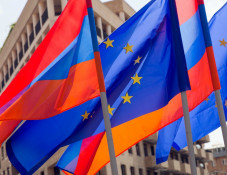
Will Armenian specialists be engaged in restoration of Ani Cathedral? Exclusive interview with head of Anadolu Kultur
The Government of Turkey and World Monuments Fund tell about their common intent to restore the Church of the Holy Savior in Ani and Ani Cathedral next year. Will the Armenian specialists be engaged in the process of the restoration is a question still abandoned?
According to the New York-based World Monuments Fund, Ani — "one of the world's great cities in the 10th century" — was once the site of hundreds of religious buildings, palaces, fortifications, and other structures. Today it stands abandoned, and the remnants of its celebrated buildings are in a precarious state.
Culture Minister Ertugrul Gunay said in the beginning of May: “Ani, which is one of the world most important monuments, has faced many challenges and we hope to conserve the remains of the cathedral and the Church of the Holy Savior in Ani.” Turkish Minister has carefully noticed that “to conserve” Ani great economic development will be launched in the region.
“Anadolu Kultur” non-governmental cultural organization, which is famous for various initiatives contributing to the Armenian-Turkish relations, helps the partnership to cooperate with the WMF. In an exclusive interview with Panorama.am Osman Kavala has informed that preparations for the actual restoration work are expected to cost US$1 million (euro672,000) alone. The restoration is likely to start as early as in 2012 and is expected to take four years.
Mr. Kavala was unable to tell us anything about the engagement of Armenian specialists in the project. “Anadolu Kultur is helping this project to be realized, but it is not an official party in this agreement,” he said.
Gagik Gyurjan, the head of International Council of Monuments and Sites Armenia, said Turkish statesmen were against to engage any Armenian specialist – architects, archeologists, into the project.
“Their specialists are not against to have a common work with us. But referring to the official permission, our states lack diplomatic relations,” Gyurjian said adding he was unsure the NGOs could get that permission from the state for the Armenian specialists.
Osman Kavala said in April, they have organized a workshop in cooperation with by the Research Center for Anatolian Civilizations of the Koc University, where architects from Armenia have participated and discussed the restoration issues with their colleagues from Turkey and WMF experts. “I think the discussions were very beneficial,” Mr. Kavala told Panorama.am.
He said because of lacking diplomatic relations between Turkey and Armenia, the official participation of the Armenian architectural organizations in the restoration project may not be possible. “However, we emphasize the importance of such cooperation in order to maintain high standards of work and an environment of cooperation,” head of “Anadolu Kultur” said.
Gagik Gyujian says he think if the Armenian specialists are not invited to participate in the restoration process, Armenian elements and nature will be perverted.
“It would be better to use the excavation results by Nikoghayos Mar, Toromyan. Those materials are available in the Armenian agency for protection of monuments, and they will be of great importance for those activities,” Gyujian said adding that those materials would be provided when Armenian specialists were engages into the restoration process.
Armenian-Turkish cultural dialogue apologist Osman Kavala told us they would try to facilitate scientific exchange and cooperation through academic and civil organizations “until the official relations are resumed.”
Gagik Gyurjan said International Council of Monuments and Sites Armenia has officially requested ICOMOS to get through WMF permission for Armenian specialists.
“The Fund finance restoration works for the Cathedral and St. Savior, thus conditions are expected to be made,” Gyurjian thinks. The request sent to ICOMOS a month ago is still left without any answer.
Newsfeed
Videos






























